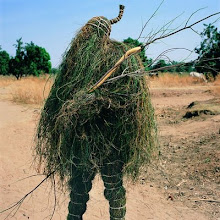"It has been reported that the ratel’s inclination for honey has resulted in a mutualistic relationship with sub-Saharan African birds called greater honeyguides (Indicator indicator). Honeyguides derive their name from a well-supported mutualistic relationship with humans where the bird actually guides humans to bee hives, using calls to recruit humans before guiding them to a known hive on their territory. The Bushmen that tend to cooperate with honeyguides incapacitate bees using smoke. The birds, along with eating larva, honey, and wax from the hives are often offered honey as a “thank you” by the Bushmen. While the relationship between humans and honeyguides is well documented and studied, many scientists argue that the relationship between honeyguides and badgers is not mutualistic and may be seen as an association due to honeyguides taking advantage of the opened hive. Regardless, the birds find it difficult to near impossible to access honeybee hives without the assistance of something like a large mammal (human or badger)." more from Scientific-Illustration
March 6, 2010
Honeyguides
"It has been reported that the ratel’s inclination for honey has resulted in a mutualistic relationship with sub-Saharan African birds called greater honeyguides (Indicator indicator). Honeyguides derive their name from a well-supported mutualistic relationship with humans where the bird actually guides humans to bee hives, using calls to recruit humans before guiding them to a known hive on their territory. The Bushmen that tend to cooperate with honeyguides incapacitate bees using smoke. The birds, along with eating larva, honey, and wax from the hives are often offered honey as a “thank you” by the Bushmen. While the relationship between humans and honeyguides is well documented and studied, many scientists argue that the relationship between honeyguides and badgers is not mutualistic and may be seen as an association due to honeyguides taking advantage of the opened hive. Regardless, the birds find it difficult to near impossible to access honeybee hives without the assistance of something like a large mammal (human or badger)." more from Scientific-Illustration
Subscribe to:
Post Comments (Atom)

No comments:
Post a Comment